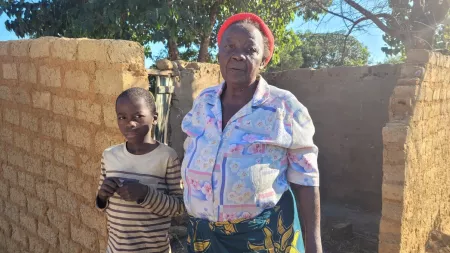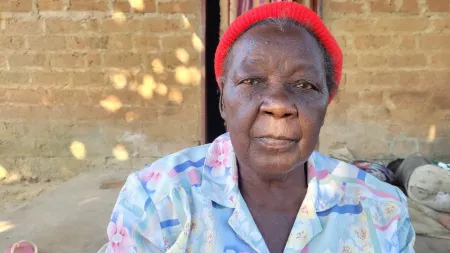Fennie Mutibo, 85, is stirring in a pot of nshima, a traditional maize polenta, in her half-open kitchen, which is separated from her house and lies across the yard. The firewood sizzles. Fennie is trying to stay dry under the high beams as it has been raining heavily for three full weeks. She adjusts her red wool hat on her head when a loud crack is heard and the kitchen collapses on her, crushing her leg under one of the heavy beams. After her kitchen comes her house.
“The soil was too soft to hold the house,” explains Fennie. She is sitting on the now dry and heat-cracked floor in front of her older sister, Theresa’s house, stretching the hurt leg out from her body. “The house was flooded one day and started tilting, I heard the plates crashing to the ground first. In the night it collapsed,” remembers Fennie, showing how her house tilted by leaning her whole body to the left.
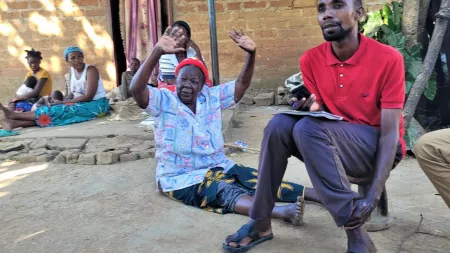
She shows how high her house had been with her hands stretching out to the sky as if she wants to hold up the roof with her bare hands. Not remembering when the house was built, she closes her eyes to think. It was old. One of the oldest in the neighborhood. “I have been here long. As long as I remember”, says the 85-year-old.
Flash floods have increased in severity and frequency in Zambia in recent decades. “I have never witnessed something like this. Until now. Rains and floods destroyed our homes. Last year it was my neighbors, this time it hit me,” says Fennie. She folds her hands together as she speaks. She used to make scones and sell them for 1 Kwacha each, which is around 5 cents. She now has bad eyesight and has no energy to work. “I cannot do a lot anymore. I ask my neighbors for help. They sometimes bring some water or food.”
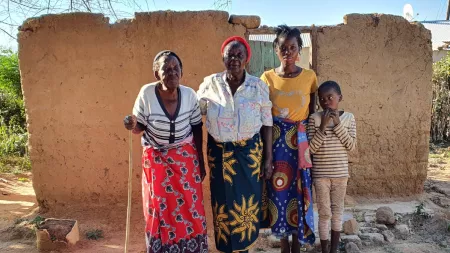
When asked if losing her house was the worst thing she ever experienced, she sighs and shakes her head. “The worst thing is when you cannot find any food. The collapsed house is just an additional thing in my life,” she says. 1953 was the worst hunger crisis she can remember. But 1985 was also a bad year. Those are the years she remembers the most from the past as they are singular events.
“Now it is more often. Every year there is not enough rain, then we do not have enough food. Or there is too much rain, then we also cannot find food and the storages are depleted,” says Fennie. When hunger strikes, her and her family’s only food source is Amaranth, a weed that requires little water to grow. It tastes like tender spinach and grows in their garden.
Fennie now lives with her sister Theresa, 88, and her sister’s grandchildren. They sit on the porch behind Fennie. A walking stick is resting on Theresa’s shoulder as she has trouble walking. Her head is covered by the same wool hat as her sister’s, but hers is black. She nods occasionally while Fennie is speaking.
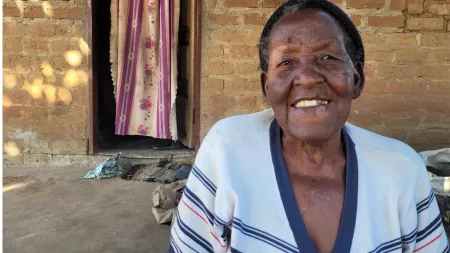
Theresa’s seven children all died from different diseases. “We take care of the grandchildren as no one else is left”, says Fennie and waves towards the girl and boy leaning against the cool house wall.
“CARE came three times to us,” says Fennie. The first time to assess the damage and needs. The whole neighborhood was severely hit by the floods. They identified 24 households that have been affected the worst and needed immediate support. “The second time they came and gave me some pots, canisters, blankets, solar lamps, and chlorine.” The third time was a cash distribution of 400 Kwacha, which is about 21 US-Dollars. On the question of what she spent her money on, she laughs, “I didn’t spend it yet. I want to use it to rebuild my house. I put it into a small tin box and hold tightly on to it.”
She uses her hands to show how small she folded the money, so it fits snuggly in the tin box. Pressing her hands close to her heart, showing how precious it is to her and how proud she is to have kept it safe. She hopes that she soon can cook Nshima in her own kitchen again, sleep under her own roof and that the next flood will not hit them. “You never know what will happen, but you have to continue anyway,” Fennie concludes.
